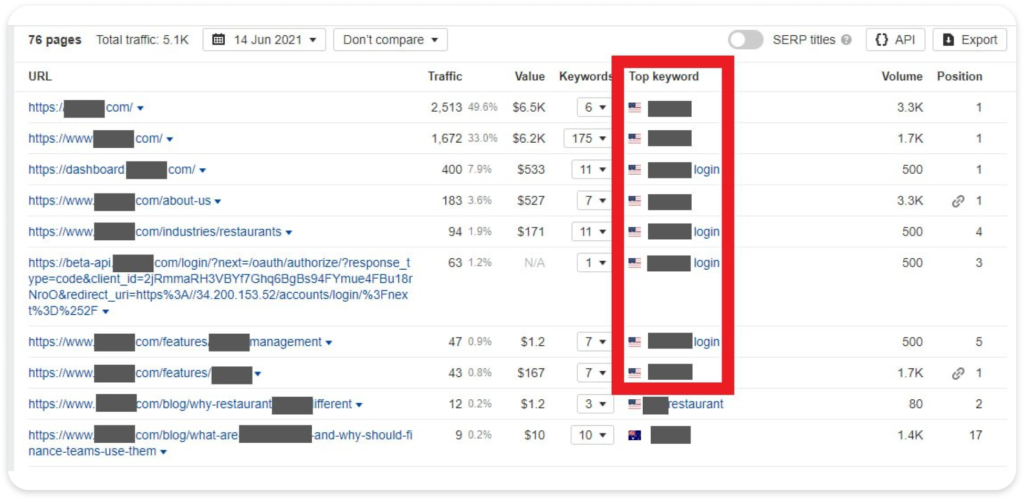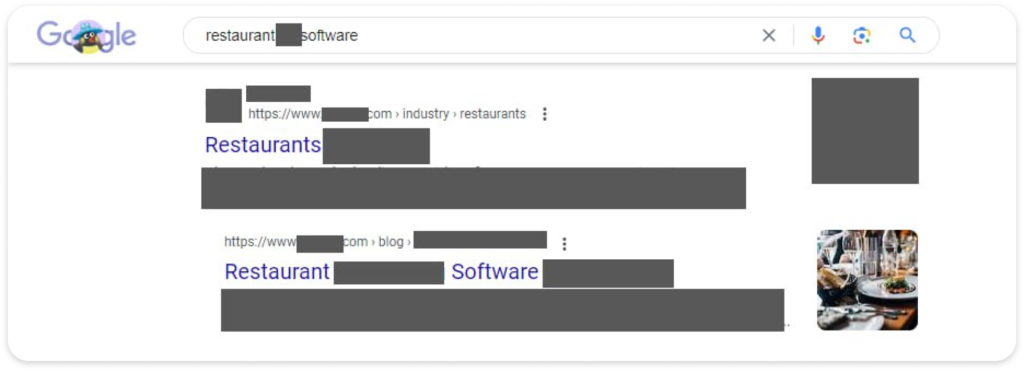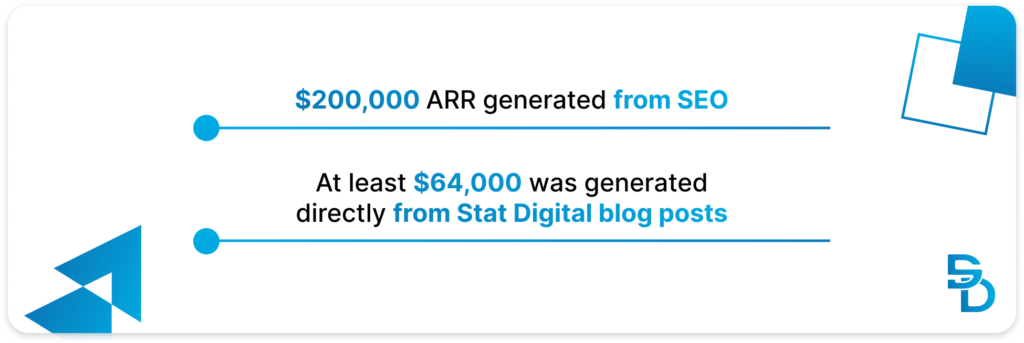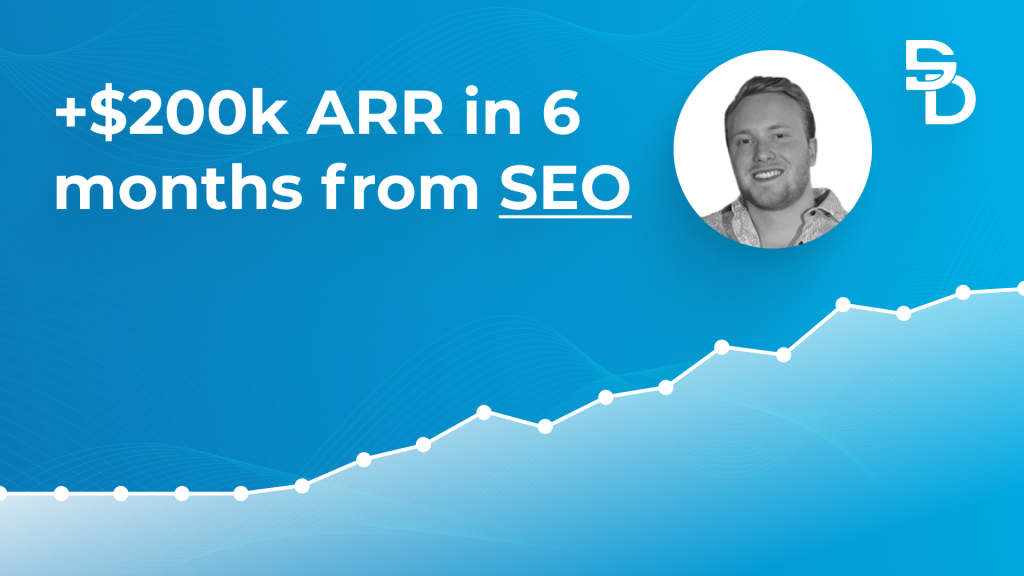In late Q1 of 2021, we signed a sales-led B2B fintech company as a new content marketing client.
Before working together, they were primarily growing through cold calling with their sales team.
They wanted to start growing more through inbound and SEO, but they were struggling with:
- Generating little-to-no demos from their blog posts.
- Producing blog content without an SEO strategy.
- Not generating new demand from SEO (the only people visiting their website already knew who they were).
- A lack of time to create content consistently.
- Breaking into higher-value industries.
But after one year of working together, 27 blog posts, and an investment of less than $30,000…

- Our blog posts were directly generating 17 demos per month, totaling over 170+ in a year.
- Total demos generated from SEO (blog posts and landing pages) reached 48 demos per month, totaling 552 in a year.
- In H1 of 2022 alone, 200k ARR was added from SEO.
- Blog visitors grew from 600 to 5,500 per month.
This case study will lay out:
- Our Client’s State of SEO Before Working Together
- 5 Challenges That Were Holding Our Client Back
- The Cost of Not Addressing Our Client’s Challenges
- Our Strategy to Dominate Google Search Results Industry-By-Industry
- How We Created Customer-Focused Content
- The Outcome of Solving Our Client’s Challenges
Our Client’s State of SEO Before Working Together
So how was this B2B Fintech’s SEO and content marketing performing before working with Stat Digital?
They had very little SEO presence — most of their traffic was coming through branded search. So they were lucky if they generated even 1 demo per month from their blog.
This meant:
- They weren’t capturing new leads and increasing brand awareness because the only people who visited our client’s website were searching for their company.
- Only 2 blog posts ranked on the first page of Google, bringing only a few hundred visits per month.
- Because they had minimal SEO traction, none of their industry or feature landing pages ranked to bring in visitors from organic search.
In this Ahrefs screenshot, you can see that virtually all of our client’s traffic came from branded searches.

5 Challenges Holding Our Client Back
These lackluster SEO results were caused by some common challenges in the B2B SaaS world…
Low meeting-to-customer conversion rate, long sales cycles, and costly CPA
Our client’s initial growth was very sales-led, meaning they had to rely heavily on cold calling to generate demos and new customers.
There’s nothing wrong with sales reps doing outreach, but it was inherently causing inefficiencies:

- Only 46% of demos booked show up to the demo
- Of the 46% that show up to the demo, only 35% become customers
Additionally, our client started running paid ads, with a cost per demo ranging from around $200 to $400 throughout our engagement. Although these ads were profitable, they had to rely on paying a fixed amount per demo.
SEO, on the other hand, would help decrease their cost per demo as their results compiled over time.
Most traffic coming in was from branded search
On our initial discovery call with the director of marketing, he was under the impression that their SEO was performing well.
Hey, they were getting thousands of website visits, so they must be doing good with SEO, right?
He thought that until I plugged their domain into Ahrefs and showed him where their traffic was coming from.
The thousands of visitors they were getting were only coming to their website because they already knew about our client’s company.
Which meant new leads weren’t finding our client through organic search, so they weren’t creating new demand or increasing brand awareness.
There was a lot more room to grow with SEO.
Producing blog content without an SEO strategy
Our client’s marketing team was writing blog posts 4 months before working with us, but they saw very few results.
The problem?
They were creating these incredibly-written blog posts full of industry insights but didn’t have the proper guidance to optimize those posts for search so they could rank on Google.
Just taking a look at their blog posts, you’d see:
-Titles not being optimized for a keyword
-Multiple blog posts on the same topic (they wanted to try a series)
-Blog posts that didn’t go as in-depth as they needed to rank
-Missed opportunities to answer common questions on a topic
All of their efforts were going to waste because their content wasn’t reaching people in their ICP through organic search.
Lack of time — relatable, right?
Like so many of us — our client was working with limited resources.
They had a 3-5 person marketing team that was juggling various responsibilities.
So although they were publishing a blog post here and there, they couldn’t maintain a consistent publishing schedule or post enough content to gain more traction on Google.
This caused an obvious problem: If you’re not creating enough of the right content for the right audience, you won’t get traffic, leads, or customers from SEO.
Breaking into new industries
Our client was founded as a fintech solution for restaurants.
But as they grew, they decided to break into similar hospitality verticals that had higher ACVs so they could continue their rapid growth.
Their average restaurant ACV was between $1,500 to $5,000 per year.
But they had plans to break into new verticals like:
- Hotels which could generate about $8,400 per location per year
- Country clubs which could generate about $18,000 per location per year
Without building trust with new industry content, they wouldn’t be able to break into new industries because they couldn’t prove to prospects that they understood their industry.
The Cost of Not Addressing Our Client’s Challenges
Let’s take a moment to pause and think:
What would have happened to our client if they didn’t hire Stat Digital for their SEO content?
- They’d have to double down on outbound and paid ads, which isn’t as cost-efficient as inbound and SEO.
- Demos booked from cold calling have a high no-show rate, and ad costs constantly increase.
- Sales would struggle to build trust when breaking into new industries.
- They’d struggle to become a “household name” that was known in their industry.
Our Strategy to Dominate Google Search Results Industry-By-Industry
Companies often dilute their authority while publishing content by failing to focus on one category or industry at a time.
So we made sure to focus on each industry, category, or feature — one at a time, until we dominated Google rankings for our target keywords.
Onboarding — understanding the customers’ pain
Before we began creating content for our client, the first thing we had to do was onboard them with an interview to get to know:
- Their customers’ pain and goals
- Common questions from prospects throughout the sales process
- Common questions from customers about their software
- Their competitor landscape
The answers we extracted from our recorded interview helped us lay out a content plan that would drive relevant traffic that converts.
Focusing on their best customers — restaurants
Our goal for the first 5 months of publishing content for our client was to gain traction in their main industry: restaurants.
We wanted to target topics that had conversion intent, so we created blog posts targeting topics and keywords that had buyer intent.
So we created content targeting topics like:
- # Best [Category] Software for Restaurants
- How to Use [Key Integration] for Restaurants
- How to Do [X Job-to-Be-Done]
- How to Solve [X Pain Point]
This content would also help us build the topical authority we needed for Google to recognize our client as an authority in their category for restaurants.
And after those 5 months, we were able to rank for those key buyer-intent keywords.

We even ranked #1 & #2 for our most important “restaurant [category] software” keyword with our blog post and their industry landing page.
Scaling horizontally into other hospitality industries
Once we dominated Google for our key restaurant topics, it was time to tap into their larger ACV industries (hotels and country clubs) that they wanted to target.
So we ran a similar play for each industry, creating that bottom-of-the-funnel content.
But since we had absolutely no authority in those industries in the eyes of Google, we decided to mix in some more top-of-the-funnel content.
These were topics like:
- What is [Topic]?
- Top [Industry] Statistics for [Year]
- [Ideas] for [Industry Topic]
These industry topics didn’t have much commercial intent but would help establish us as authorities in those industries, so our blog posts with more buyer intent could rank.

In this screenshot, you can see our blog post ranking #1 for our key “hotel [category] software” keyword.

And here, you can see our blog post and their industry landing page ranking #1 and #2 for our “country club [category]” keyword.
Making our competition hate us for dominating top keywords
As we created industry-focused content, we also made a point to cover key topics in our general category.
So we also created more content targeting topics about:
- General pain points that customers have in our category
- General goals that customers have in our category
- Best [Software or Tools] for [Our Category]
This would help us rank for more general category topics that had commercial intent but were more industry agnostic.
How We Created Customer-Focused Content
Our content strategy helped us rank for important buyer-intent keywords, but because of the sophistication of our client’s audience, we had to make sure to create content that was worthy of being #1.
Collaborating with industry experts to create content our client’s audience would care about
You can’t build authority in your category by faking your expertise.
Our client’s audience was experts in their own fields, so it was important for us to include insights in the content we created that were authentic.
So we worked directly with subject matter experts (SMEs) to create our content.
This meant that our writers would create outlines based on previous information we gathered from interviews, content meetings, and industry information.
Then, we’d create a list of questions to prepare for an interview with our designated SME, who would give us industry insights that only someone in the trenches would know about.
They’d also thoroughly review our detailed outlines to ensure they made sense.
At first, we could work directly with an internal SME to create our content (a lot of their team had restaurant experience).
But when we started to expand into industries that even our client’s employees didn’t quite understand yet, we took it upon ourselves to hire 3rd party SMEs that worked in the industries we were expanding.
Creating interesting content in a boring industry
When we looked at our client’s competitor’s content, it was boring, dry, and had barely any visuals that weren’t stock images.
So we made sure to include visuals in the form of infographics to make our content more readable and highlight key statistics that could influence readers to take action.
And since our client was well aware that their category was boring, they clarified that the content didn’t have to be as dull as the category.
We adapted to this by mixing in creative metaphors and using a light, humorous tone in the writing.
Attention to detail and effort to get things right
We had absolutely zero experience in our client’s industry before creating our first blog post.
So naturally, there was a learning curve to getting to know their expectations and getting familiar with industry nuances.
So after the first blog post, which wasn’t perfect, we spent an hour listening to the marketing team’s feedback on what could be improved.
Which we gladly took and used for future content.
From that point forward, we only had to receive minimal feedback, which the marketing team certainly appreciated.
In fact, this is what their marketing director had to say about how we respond to constructive feedback by the end of their time at the company:
“I have been working with Jacob for more than a year now. First thing I would say is that he does a fantastic job in listening to our needs, and being open to feedback, even reworking articles multiple times until it gets to where we need it to be. That dedication to customer service has worked wonders.”
The Outcome Of Solving Our Client’s Challenges
Before working with Stat Digital, our client wasn’t even ranking on the first three pages of Google for their target keywords.
One year later, 20+ (out of 27) of the blog posts we created for our client ranked on the first page of Google.
Here’s what their director of marketing had to say about this:
“Today, Jacob’s articles for us have pushed our website search rankings to the top first or second place in many of our target keywords and search terms. He just knows what will play well with the audience. We’ve even generated white-papers and gated assets with some of his content and they have been received very well by our prospects. Highly recommend him — he will make you money!”
But here’s precisely how Stat Digital was able to make an impact:
Generated at least $200,000 ARR directly from our blog posts and SEO in H1 of 2022
Unfortunately, our client’s attribution tracking link broke in Salesforce halfway through 2022, so they could only retrieve partial revenue attribution data from the first half of the year.
However, here’s what their marketing team said was the minimum revenue attributed from working with us in just H1 of 2022:

- At least $200,000 ARR generated from SEO
- At least $64,000 ARR was generated directly from our blog posts
Revenue was our top priority, but we also:
- Grew monthly blog visitors from 613 to 5,555
- Helped generate 552 demos in a year

Sales reps were enabled with content that built trust with prospects in new industries
When our client was expanding into new industries like country clubs and hotels, it was important that prospects knew that our client understood their industry.
So whenever the sales team would identify areas in the sales process that they needed to build more trust in, they’d let us know, and we’d create that content.
Sales reps then used our blog content to send to prospects so they could build trust by showing that they understood their prospects’ industry.
Inbound close rates > outbound close rates
While outbound close rates were around 35%, their win rate increased drastically from solely relying on outbound to inbound.
The inbound leads were much more qualified, and the data showed that.

71% of demos generated from SEO closed — becoming paying customers.
Lessons Learned From Creating Content for a Sales-Led B2B Fintech Company
Working with our client over the past year helped us learn these valuable lessons that we’ve taken with us to help other B2B SaaS companies:
- Focus on creating content industry-by-industry as you expand horizontally. Create content for the industry that makes up your best customer base first. Then once you dominate the SERPs for that industry, you can move on to the next.
- Topical authority is crucial for ranking and becoming an industry authority. Before our blog posts and their key landing pages could rank for their target keywords, we had to create 10+ pieces of content for each industry.
- Create content for topics that target WHY your customers choose your software. Talk to sales and determine what customers need to know before buying, then use that qualitative data to create your strategy.
- Create linkable resources to help improve your website’s overall rankings. Creating content that other websites like to link to (like statistics pages) helps build natural backlinks that increase your overall rankings and authority.
- Use real expertise in your content. Work with subject matter experts (internally or externally) to create content that your audience will actually resonate with.
How to Work with Us
Want to get similar results as our client did in this case study?
Schedule a consultation meeting with us here. We’ll happily set you up on the right path, whether that means working together or not.

